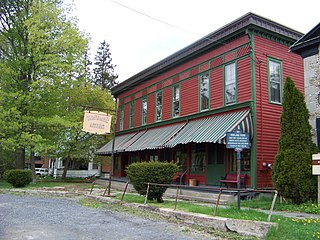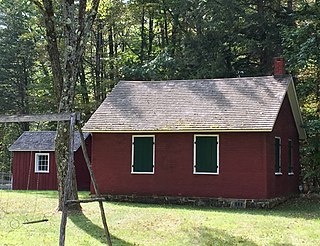
This is intended to be a complete list of properties and districts listed on the National Register of Historic Places in Orleans County, New York. The locations of National Register properties and districts may be seen in a map by clicking on "Map of all coordinates". Two listings, the New York State Barge Canal and the Cobblestone Historic District, are further designated a National Historic Landmark.

The Hurley Historic District encompasses the center of the hamlet of Hurley, the main settlement area of the town of Hurley, New York. Stretched along US 209, the hamlet includes one of the finest concentrations of colonial Dutch architecture in the United States. Settled by the Dutch in the 17th century, its architecture has retained the influence of that period. The village is also historically significant as a temporary home of the seat of New York government during the American Revolutionary War. It was designated a National Historic Landmark in 1961.

The O'Brien General Store and Post Office is a combined store and post office located at Schatzell and Charles streets in the hamlet of Rhinecliff, New York, United States, across from the community's central plaza. It is a two-building Italianate complex built in the late 19th century. The western half houses the store and the eastern the post office, which serves the small 12574 ZIP Code roughly contiguous with the riverside hamlet.

The Somers Hamlet Historic District is a historic district located along US 202 in Somers Hamlet in Westchester County, New York, United States. It is the stretch of highway between the junctions with NY 100 and NY 116, including small portions of both highways. Two side streets, Deans Bridge Road and The Lane, are also included, bringing its total area to 56 acres.

The Indian Brook Road Historic District is located on both sides of that street's intersection with US 9 east of Garrison, New York, United States. Its 30 acres (12 ha) contain 15 buildings, all but two of which are considered contributing properties to its historic character.

There are 73 properties listed on the National Register of Historic Places in Albany, New York, United States. Six are additionally designated as National Historic Landmarks (NHLs), the most of any city in the state after New York City. Another 14 are historic districts, for which 20 of the listings are also contributing properties. Two properties, both buildings, that had been listed in the past but have since been demolished have been delisted; one building that is also no longer extant remains listed.

Breakabeen Historic District is a national historic district located at the hamlet of Breakabeen in Schoharie County, New York. The district includes 33 contributing buildings. Most of the buildings were built in the early to mid-19th century in a vernacular Greek Revival style. Several buildings are temple-like featuring one or two story high portico supported by square columns. The most interesting structure is a post American Civil War hotel. It is a large, square, two story building with a flat roof, exhibiting a variation of an Italian Villa theme.

Sherwood Equal Rights Historic District is a national historic district located at Sherwood in Cayuga County, New York. The district consists of 29 properties containing 27 contributing primary buildings, one contributing site (cemetery), three contributing carriage houses and one non-contributing building in the historic core of the hamlet of Sherwood. It encompasses the entire hamlet and includes several commercial / civic structures at the intersection of New York State Route 34B and Sherwod Road. The structures commemorate the historical Quaker community's dedication to abolition, women's rights, and education.

Russia Corners Historic District is a national historic district located at the hamlet of Russia in Herkimer County, New York. The district includes six contributing buildings. They are the Russia Union Church (1820), Russia District School No. 5, and four residences built between about 1803 and 1830.

Middlefield Hamlet Historic District is a national historic district located at Middlefield in Otsego County, New York. It encompasses 24 contributing principal buildings and eight contributing dependencies. All but one of the buildings are residences. It also includes a Greek Revival style frame store building.

Southold Historic District is a national historic district located at the hamlet of Southold in Suffolk County, New York. The district has 86 contributing buildings, one contributing site, and two contributing objects. The majority are residential buildings built either with a heavy timber frame or balloon frame construction and range in date from about 1656 to about 1938. The district also includes three prominent religious facilities and educational facilities.

North Blenheim Historic District is a national historic district located at the hamlet of North Blenheim in Schoharie County, New York. The district includes 25 contributing buildings and one contributing site. Most of the buildings exhibit some influence from the vernacular Greek Revival style. Located within the district is an exceptional Greek Revival church built in 1841.

Riders Mills Historic District is a national historic district located at Chatham in Columbia County, New York. The district includes 20 contributing buildings, eight contributing structures, and one contributing site. It includes the remnants of the one thriving hamlet of Riders Mills, located along the Kinderhook Creek and largely wiped out by a flood in 1869. Most of the buildings are residential and date to the early to mid-19th century and reflect a variety of popular architectural styles such as Georgian and Greek Revival. In addition to residences, the district includes a schoolhouse and bridge. There are also eight known archaeological sites, mostly the foundations of mills and residences.

Hillsdale Hamlet Historic District is a national historic district located at Hillsdale in Columbia County, New York. The district includes 128 contributing buildings, five contributing sites, and two contributing objects. It encompasses the historic core of the hamlet of Hillsdale.

Essex Village Historic District is a national historic district located at Essex in Essex County, New York. The district contains 150 contributing buildings. It encompasses the historic core of the hamlet of Essex and primarily contains early-19th-century buildings. The predominant building materials are clapboarded wood frame, brick, and stone and none of the buildings exceed 2+1⁄2 stories in height. The oldest documented structure is Dower House, built prior to 1793. Other notable buildings include Wright's Inn (1798), Essex Free Library (1818), and "Hickory Hill" (1822), "Rosslyn", the "Old Brick Schoolhouse" (1830), and "Greystone" (1853).

Glen Historic District is a national historic district located at Glen in Montgomery County, New York. It includes 52 contributing buildings and two contributing sites. The district encompasses the historic core of a rural crossroads hamlet. The majority of the structures are one and one half or two story, timber-framed buildings with gable roofs. At the crossroads are the most distinguished buildings: two large Federal style residences, a mid-19th century general store, and a distinguished, Second Empire style brick residence built in 1878.

Hamlet of Warrensburgh Historic District is a national historic district located at Warrensburg, Warren County, New York. It includes 351 contributing buildings, three contributing sites, and five contributing structures. It encompasses the historic commercial core on the north side of the Schroon River and historic industrial core on the south side of the river of the hamlet of Warrensburgh. It includes more high styled residences and notable civic and religious properties on the north side and vernacular residences on the south side. Notable commercial buildings include the Woodward Block, Wills Block, bank building at 138 Main Street, and the former Sturdevan's Bakery. Three historic churches within the district are the Church of the Holy Cross (1864), First Methodist Church (1904), and United Presbyterian Church (1840). Civic buildings located within the district are the Richards Library (1900) and Warrensburgh Central School (1942). In addition, the Floyd Bennett Park and Bandstand (1930–31), named for Warrensburg native Floyd Bennett, is within the district.

Rensselaerville Historic District is a national historic district located at Rensselaerville in Albany County, New York. It includes 86 contributing buildings and encompasses most of the buildings in the hamlet of Rensselaerville. Most date to the early 19th century and are predominantly Greek Revival in style.

Schodack Landing Historic District is a national historic district located at Schodack Landing in Rensselaer County, New York. It consists of 86 contributing buildings located in the hamlet of Schodack Landing. The district includes a variety of buildings dated from the 18th through early 20th centuries. They are mostly residential buildings, but include a post office, two churches, a nursing home, a tavern, and a store. There are notable buildings in the Greek Revival and Italianate styles.

Hollins–Roundhouse Historic District is a national historic district in Baltimore, Maryland, United States. It is a primarily residential area characterized by 19th century rowhouses. The neighborhood is historically significant due to its association with the development of rail transportation in Maryland. Additional historical significance comes from the neighborhood's association with ethnic immigration to Baltimore. During the 1840s and 1850s the area was a center of settlement for Baltimore's German and Irish communities, many of whom immigrated to the United States to work in the rail industry. Later, from the 1880s to the 1920s, the neighborhood became established as the center of Baltimore's Lithuanian immigrant community. Because of the large Lithuanian population in the area north of Hollins Street, the area became known as Little Lithuania. A few remnants of the neighborhood's Lithuanian heritage still remain, such as Lithuanian Hall located on Hollins Street.
























